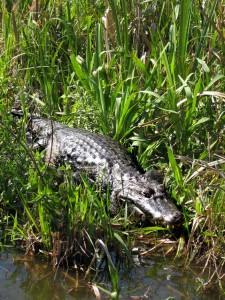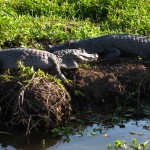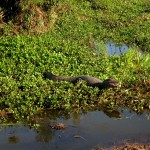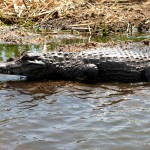You Say Yacaré, I say Cayman
While in the marshes of Iberá, our guide told us there were three types of large reptiles living in the lagunas: the green cayman, some sort of blunt nosed cayman and the black cayman, which grow to be the largest — up to about 3 m. The black variety was by far the most common during our visit.
As far as we could observe, they spend much of the day recharging their cold-blooded batteries by basking in the sun, often with their mouths hinged open. They are so preternaturally still for such long periods of time, we were all starting to joke that the lodge had placed plastic caymans around the estuaries for tours.
Just as you would find yourself lulled into a false sense of security though, one would randomly scurry off into the water incredibly quickly. (The first time that happened, Zoe suddenly saw the wisdom of keeping her hands out of the water while near land in the shallower depths.)
They hunt at night, eating fish when the water is cold, making their prey more sluggish and easy to catch. There is a relative of the piranha in the waters of Iberá that is supposed to be a favorite treat. We went on a night excursion and, using a strong flashlight, we could see cayman eyes reflecting back at us — glowing orbs gliding silently over the surface of the water as they searched for hapless fish. It was eerie.
Linguistically, I thought I would mention that Yacaré is the Guaranà word for the cayman, and it roughly signifies something submerged, drifting over the water with just a head poking out.
On another linguistic side note, Tom and I have been arguing over the spelling of caiman/cayman. I like it with a “y” and Tom prefers it with an “i” — you will probably see both in the entries as the editorial battle rages on. Yes, I know, we need to find something more meaty to argue over, really!




El yacaré es una especie del género caimán. El nombre cientÃfico es Caiman yacare (asà es como se escribe en latÃn, porque en ese idioma no hay acento ortográfico). Sin embargo, “Cayman” se utiliza en el nombre oficial de las Islas Caimán: Cayman Islands. “Caimán” es una palabra de origen taÃno, un antiguo dialecto de la Antillas, y yacaré es una palabra guaranÃ. Creo que Tom tiene razón en que la versión en ingles deberÃa ser “caiman” y no “cayman” (digo esto sin ánimo de provocar un conflicto conyugal, jaja).
Los guaranÃes eran expertos observadores de la flora y la fauna sudamericana, y han aportado centenares de términos a la taxonomÃa cientìfica: sorprendentemente, la contribución de la lengua guaranà es la tercera en importancia después del griego y el latÃn. Algunos nombres guaranÃes de plantas y animales: jacarandá, ombú, viraró, carpincho, yaguareté, ñandú, pecarÃ, tapir, tatú…
Siento admiración por la excelente educación que Vd le ofrece a sus niñas, Michele.
Michele and I are always delighted to receive blog comments, but since you’ve agreed with my position here, I have to say I was even more excited than usual to see your contribution.
Welcome to the discussion!
Bienvenidos. Gracias para tu repuesta!!!!
Tengo que decirte que Tom no tiene razón (es un estado permanente de maridos — jaja)! Estoy seguro que puedo escribir cayman (en Inglés) con “y” porque el diccionario Merriam-Webster dice:
cai·man
Variant(s): also cay·man \ˈkÄ-mÉ™n; kÄ-ˈman, kÄ«-\
Function: noun
Any of several Central and South American crocodilians (genera Caiman, Melanosuchus, and Paleosuchus) similar to alligators